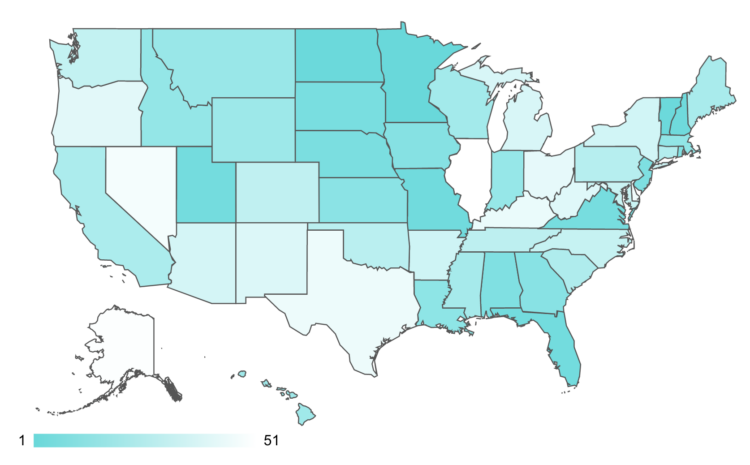
The darker the blue, the higher the ranking in unemployment rate change. Graphic WalletHub
Oct. 25. September’s jobs report showed a slowdown in growth. The economy gained 263,000 non-farm payroll jobs, down from 315,000 the previous month. In September, there were notable gains in sectors including health care and leisure and hospitality.
Now, the U.S. unemployment rate sits at 3.5%, down from the nearly historic high of 14.7 percent in April 2020, due to a combination of vaccinations and states removing restrictions.
However, inflation and the potential of a recession threaten to push the unemployment rate higher again if Federal Reserve rate increases are not able to stave them off.
In order to take stock of how unemployment rates are changing throughout the U.S., WalletHub compared the 50 states and the District of Columbia based on six key metrics that compare unemployment rate statistics from the latest month for which data is available (September 2022) to key dates in 2022, 2021, 2020 and 2019.
Findings on NC
North Carolina ranked 35th in unemployment rate changes by state.
—Unemployment rate (September 2022): 3.6 percent
—Change in unemployment (September 2022 vs. August 2022): 2.6 percent
—Change in unemployment (September 2022 vs. September 2021): -18.8 percent
—Change in unemployment (September 2022 vs. September 2020): -41.7 percent
—Change in unemployment (September 2022 vs. September 2019): -6.6 percent
—Not Seasonally Adjusted Continued Claims (September 2022 vs. August 2022): -7.1 percent
Other states
The states with the highest ranking in unemployment rate changes by state are: Minnesota, first, followed in order by North Dakota, Vermont ,New Hampshire and Missouri. The states with lowest rankings are: Delaware at 47th, followed by Nevada, District of Columbia, Alaska and Illinois.
Thoughts from an expert

Joe R. Eulberg
Joe R. Eulberg, assistant professor, College of Business, Innovation, Leadership and Technology – Marymount University, answered these questions for WalletHub.
What are the best ways for state and local authorities to ensure a cost-effective rebound from the economic aftermath of the pandemic?
State and local authorities are seeing post-pandemic economic progress in large part because they are encouraging organizations to pay better and to have better job offerings. Job seekers like the greater work flexibility and the reality that pay rates have been consistently moving up.
What are the most resilient industries and fields during the current crisis?
Areas like health care (especially pharma), tech, financial services, and transportation stayed strong in the pandemic and continue to do so.
What job skills do you think will be the most sought after in the post-coronavirus job market?
Because there was so much decline in service industries (e.g. hospitality, restaurants, travel) there has been a need to bring back those job skills.
What’s in store for the job market in 2022?
The 2022 job market so far has had greater volatility, in large part because people have much greater choices in jobs. People are less afraid to leave their jobs because the option of more flexible and higher-paying jobs are more readily available. It is likely there will be more voluntary job changes in the market than we have seen for years.

Discussion
No comments yet.